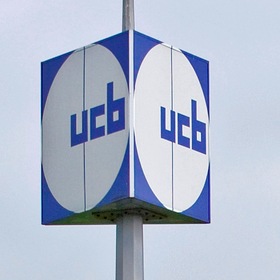UCB reinforces commitment to epilepsy community on European Epilepsy Day
For the attention of accredited medical and business writers
Brussels (Belgium), 14 February 2011 – 0001 CET – UCB, a leading biopharmaceutical company at the forefront of epilepsy treatment and research, is marking the first European Epilepsy Day by reinforcing its commitment to improving the lives of people with epilepsy.
With marketed therapies like Vimpat® (lacosamide) and Keppra® (levetiracetam), and an innovative research and development program, UCB is privileged to help meet the needs of the epilepsy community in the quest worldwide for improved epilepsy care for patients of all ages.

| “There is still a need for new antiepileptic drugs, as demonstrated by the fact that, in just two years since its launch, lacosamide has now been used by 100,000 people with epilepsy. UCB is also committed to delivering solutions that go beyond treatment, through our successful partnerships with healthcare professionals, our patient support programmes and our innovative research and development strategy.” commented Prof. Dr. Iris Löw-Friedrich, Chief Medical Officer, UCB. |
Latest milestones for Vimpat® and Keppra®
100,000 people with epilepsy have been prescribed lacosamide since its first launch in Europe in September 2008, demonstrating the continuing need for new AEDs for epilepsy patients with uncontrolled partial onset seizures.
Lacosamide is now available in 21 countries, with latest launches in Canada and Italy. Further launches across other European and international markets will continue over the next 12 months. These launches are supported by new data showing that lacosamide can optimise combination treatment of epilepsy patients with partial onset seizures, regardless of the type of concomitant AED used. These data have shown:1,2,3,4
• Efficacy and tolerability of lacosamide as adjunctive treatment of partial onset seizures in adults with epilepsy
• Significant reduction in partial onset seizure over placebo in adult patients regardless of the concomitant antiepileptic drug therapy used
• Sustained efficacy and tolerability of lacosamide for up to 5 years of treatment when used as add-on treatment for uncontrolled partial onset seizures in adults with epilepsy
Over a decade after levetiracetam was launched in Europe and in the US, the number of people with epilepsy who have access to this treatment continues to rise. In 2009, the range of indications for levetiracetam in Europe was extended to adjunctive treatment of partial onset seizures in infants and children with epilepsy from one month to less than four years. And in 2010, levetiracetam was approved as E Keppra® in Japan for the adjunctive treatment of partial onset seizures in adults, further broadening the range of people worldwide who can benefit from levetiracetam.
Committed to developing innovative therapies for the future
With over 20 AEDs introduced since the first epilepsy treatment almost 100 years ago, the increased availability of newer AEDs should enable treatment to be tailored to individual patient needs. However, up to 30% of people with epilepsy do not respond to currently available treatments and still have uncontrolled seizures.5,6
At its epilepsy research centre near Brussels, Belgium, UCB NewMedicines™ is continuing to research new therapies for people who do not have adequate control of their epilepsy with today’s antiepileptic drugs (AEDs).
| “Despite the advances in epilepsy treatment of the last 20 years, our goal of finding new AEDs that either provide seizure freedom without unacceptable side effects or prevent or cure the disease, is as important as ever,” pointed out Dr. Henrik Klitgaard, Vice President, CNS Research, UCB Braine l’Alleud. | 
|
UCB NewMedicines™ has built an externally-connected, ‘open-innovation’ business model and scientists have an extensive partnering network with leading academic groups and other research organisations across the world. These collaborations involve approaches including basic research on the molecular and cellular mechanisms underlying the pathophysiology of epilepsy, applied research on novel drug targets for new treatments and technologies aimed at evaluating unique approaches for the medical treatment of epilepsy.
“Today’s discoveries form the foundation for tomorrow’s treatments, and our scientists recognize the importance of sharing and exchanging ideas and achievements with others at the forefront of epilepsy research,” concluded Dr. Klitgaard.
Committed to partnership with healthcare professionals
During the last decade, UCB has worked with national and international epilepsy organisations, including the International Bureau for Epilepsy (IBE) and the International League Against Epilepsy (ILAE). These initiatives are aiming to raise awareness and improve public understanding about epilepsy, reduce the stigma and discrimination associated with epilepsy, and help people with epilepsy to gain access to appropriate treatment.
References
1. Sake J-K, Hebert D, Isojarvi J, Doty P, De Backer M, Davies K, Eggert-Formella A, Zackheim J. A Pooled Analysis of Lacosamide Clinical Trial Data Grouped by Mechanism of Action of Concomitant Antiepileptic Drugs. CNS Drugs 2010; 24(12): 1055-1068
2. Chung S, Ben-Menachem E, Sperling MR, Rosenfeld W, Fountain NB, Benbadis S, Hebert D, Isojärvi J, Doty P. Examining the Clinical Utility of Lacosamide. CNS Drugs 2010; 24 (12): 1041-1054
3. Faught E, Chung S, Husain A, Isojarvi J, McShea C, Doty P. Long-Term Efficacy of Lacosamide as Adjunctive Therapy in Patients with Uncontrolled POS: Results from a Phase III Open-Label Extension Trial. Presented at the 64th Annual Meeting of the American Epilepsy Society, San Antonio, USA, 3-7 December 2010
4. Rosenfeld, W., Rosenow, F., Isojarvi, J., Hebert, D. & Doty, P. Long-term safety and tolerability of lacosamide for partial onset seizures: an interim evaluation of patients expose to lacosamide in double-blind and open-label trials. Neurology 2010; 74 (9): Suppl 2, PA452-3
5. WHO. Epilepsy: aetiology, epidemiology and prognosis. Available at: www.who.int/mediacentre/factsheets/fs999/en/ [Accessed 3rd February 2011]
6. Epilepsy in the WHO European Region: Fostering Epilepsy Care in Europe http://www.ibe-epilepsy.org/downloads/EURO%20Report%20160510.pdf [Accessed 3rd February 2011]
Important safety information about Vimpat® in the EU and EEA
Vimpat® is indicated as adjunctive therapy in the treatment of partial onset seizures with or without secondary generalization in patients with epilepsy aged 16 years and older. Vimpat® solution for infusion is an alternative for patients when oral administration is temporarily not feasible. Contraindications: Hypersensitivity to the active substance or any of the excipients; known second- or third-degree atrioventricular (AV) block. Special warnings and precautions for use: Treatment with lacosamide has been associated with dizziness which could increase the occurrence of accidental injury or falls. Therefore, patients should be advised to exercise caution until they are familiar with the potential effects of the medicine. Prolongations in PR interval with lacosamide have been observed in clinical studies. Cases with second and third degree AV block associated with lacosamide treatment have been reported in post-marketing experience. Lacosamide should be used with caution in patients with known conduction problems or severe cardiac disease such as a history of myocardial infarction or heart failure. Caution should especially be exerted when treating elderly patients as they may be at an increased risk of cardiac disorders or when lacosamide is used in combination with products known to be associated with PR prolongation. Suicidal ideation and behavior have been reported in patients treated with anti-epileptic agents. Therefore patients should be monitored for signs of suicidal ideation and behaviors and appropriate treatment should be considered. Patients (and caregivers of patients) should be advised to seek medical advice should signs of suicidal ideation or behavior emerge. Lacosamide syrup contains sodium methylhydroxybenzoate (E219), which may cause allergic reaction (possibly delayed). Patients with rare hereditary problems of fructose intolerance should not take this medicine. The syrup contains aspartame (E951), a source of phenylalanine, which may be harmful for people with phenylketonuria. Both the syrup and solution for infusion contain sodium. To be taken into consideration for patients on a controlled sodium diet. Effects on ability to drive and use machines: Lacosamide may have minor to moderate influence on the ability to drive and use machines. Lacosamide treatment has been associated with dizziness and blurred vision. Accordingly patients should be advised not to drive a car or to operate other potentially hazardous machinery until they are familiar with the effects of lacosamide on their ability to perform such activities. Laboratory abnormalities: Abnormalities in liver function tests have been observed in controlled trials with lacosamide in adult patients with partial onset seizures who were taking 1-3 concomitant antiepileptic drugs. Elevations of ALT to ≥3XULN occurred in 0.7% (7/935) of lacosamide patients and 0% (0/356) of placebo patients. Multiorgan Hypersensitivity Reactions: Multiorgan hypersensitivity reactions have been reported in patients treated with some antiepileptic agents. These reactions are variable in expression but typically present with fever and rash and can be associated with involvement of different organ systems. Potential cases have been reported rarely with lacosamide and if multiorgan hypersensitivity reaction is suspected, lacosamide should be discontinued. Undesirable effects: The most common adverse reactions (≥10 %) are dizziness, headache, diplopia, and nausea. Other common adverse reactions (1–<10 %) are depression, confusional state, balance disorder, coordination abnormal, memory impairment, cognitive disorder, somnolence, tremor, nystagmus, hypoesthesia, dysarthria, disturbance in attention, vision blurred, vertigo, tinnitus, vomiting, constipation, flatulence, dyspepsia, dry mouth, pruritus, rash, muscle spasms, gait disturbance, asthenia, fatigue, irritability, injection site pain or discomfort (specific to solution for infusion), irritation (specific to solution for infusion), fall, and skin laceration. Refer to the European Summary of Product Characteristics for other adverse reactions and full prescribing information. Date of revision 25th October 2010
Important Safety Information about Keppra® in EU and EEA
In the European Union and the EEA Keppra® is indicated as monotherapy in the treatment of partial onset seizures with or without secondary generalization in patients from 16 years of age with newly diagnosed epilepsy. Keppra® is indicated as adjunctive therapy in the treatment of partial onset seizures with or without secondary generalization in adults, infants and children from 1 month of age with epilepsy. Keppra® is indicated as adjunctive therapy in the treatment of myoclonic seizures in adults and adolescents from 12 years of age with Juvenile Myoclonic Epilepsy. Keppra® is indicated as adjunctive therapy in the treatment of primary generalized tonic-clonic seizures in adults and adolescents from 12 years of age with idiopathic generalized epilepsy. Keppra® concentrate is an alternative for patients when oral administration is temporarily not feasible.
Contraindication: Keppra® is contraindicated in patients with hypersensitivity to levetiracetam or other pyrrolidone derivatives or any of the excipients. Special warnings and precautions for use: In accordance with clinical practice if Keppra® has to be discontinued it is recommended to withdraw it gradually. The administration of Keppra® to patients with renal impairment may require dose adjustment in patients with severely impaired hepatic function. Suicide, suicide attempt and suicidal ideation and behaviour have been reported in patients treated with antiepileptic agents (including levetiracetam). Patients should be monitored for signs or depression and/or suicidal ideation and behaviours and appropriate treatment should be considered. Undesirable effects: In pooled safety data from clinical studies conducted with Keppra® oral formulations in patients with partial onset seizures the most commonly reported undesirable effects were somnolence, asthenia and dizziness. In monotherapy the most commonly reported undesirable effects were fatigue and somnolence. In paediatric patients (4-16 years of age) the most commonly reported undesirable effects were somnolence, hostility, nervousness, emotional lability, agitation, anorexia, asthenia and headache. Safety results in paediatric patients were consistent with the safety profile of levetiracetam in older children aged 4-16 years. In a study conducted with adults and adolescents with myoclonic seizures the most commonly reported undesirable effects were headache and somnolence. In a study conducted with adults and children (4 to 65 years) with idiopathic generalized epilepsy with primary generalized tonic-clonic seizures the most commonly reported undesirable effect was fatigue. Undesirable effects that resulted from Keppra® intravenous use are similar to those associated with Keppra® oral use. The most frequently reported adverse reactions were dizziness, somnolence, headache and postural dizziness. Date of revision 1st September 2010.
Please refer to the European summary of product characteristics for other adverse reactions and full prescribing and safety information http://www.ema.europa.eu/docs/en_GB/document_library/EPAR_-_Product_Information/human/000277/WC500041334.pdf
About Epilepsy
Epilepsy is a chronic neurological disorder affecting approximately 40 million people worldwide and six million people in Europe. Anyone can develop epilepsy; it occurs across all ages, races and genders. Uncontrolled seizures and medication side effects pose challenges to independent living, learning and employment, so the goal of epilepsy treatment is seizure freedom with minimal side effects. New medications and treatments give hope to those living with uncontrolled seizures.
About European Epilepsy Day
European Epilepsy Day is an initiative of the International Bureau for Epilepsy (IBE), an umbrella organisation of lay epilepsy associations, and the International League Against Epilepsy (ILAE), an international organisation representing healthcare professionals active in the field of epilepsy. ‘The Many Faces of Epilepsy’ is the theme for the first European Epilepsy Day, which takes place on 14th February 2011.
For further information
Nancy Nackaerts, External Communications, UCB
T +32.473.864.414, nancy.nackaerts@ucb.com
Eimear O Brien, Associate Director, Global CNS Communications
T +32 2 559 9271, eimear.obrien@ucb.com
About UCB
UCB, Brussels, Belgium (www.ucb.com) is a global biopharmaceutical company focused on the discovery and development of innovative medicines and solutions to transform the lives of people living with severe diseases of the immune system or of the central nervous system. With more than 8,000 people in about 40 countries, the company generated revenue of EUR 3.1 billion in 2009. UCB is listed on Euronext Brussels (symbol: UCB).
Forward-looking statements
This press release contains forward-looking statements based on current plans, estimates and beliefs of management. Such statements are subject to risks and uncertainties that may cause actual results to be materially different from those that may be implied by such forward-looking statements contained in this press release. Important factors that could result in such differences include: changes in general economic, business and competitive conditions, effects of future judicial decisions, changes in regulation, exchange rate fluctuations and hiring and retention of its employees.
Asset Download
Stay up-to-date on the latest news and information from UCB



